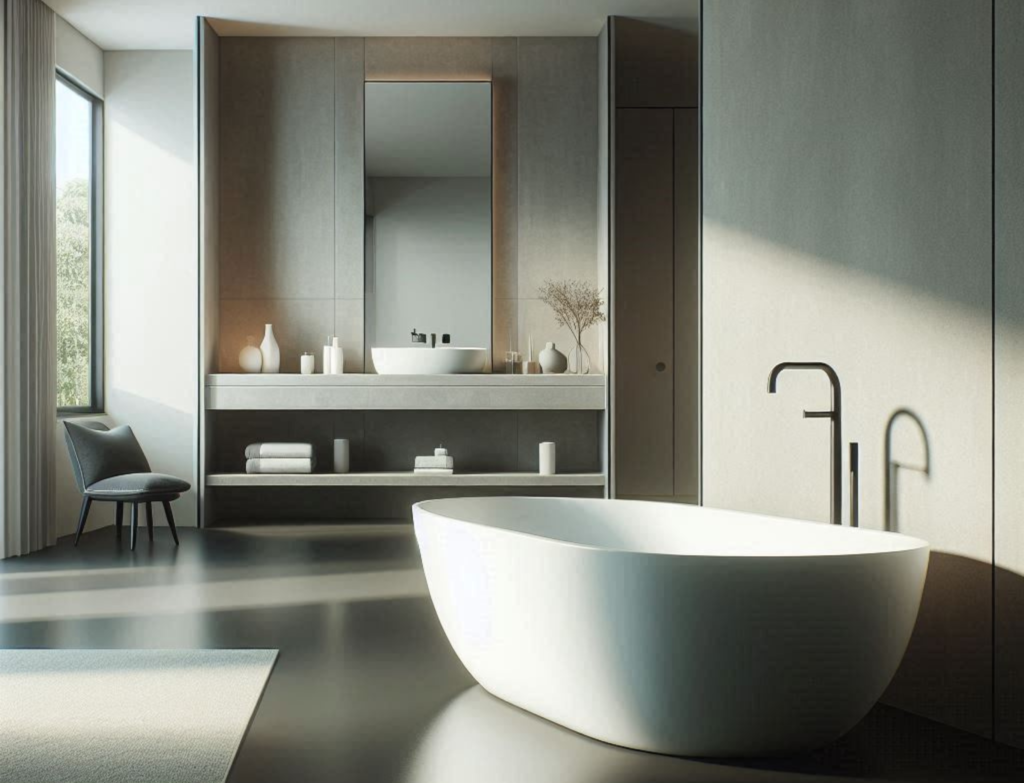
Choosing the right bath material can elevate your bathroom from a functional space to a luxurious retreat. With various options available, including 2 piece single skin acrylic, twin skin 1 piece, solid surface, and metal free-standing baths, it’s crucial to understand what each type offers. Whether you prioritize affordability, durability, elegance, or a unique aesthetic, there’s a perfect bath out there for you. This guide will walk you through the different types, helping you make an informed decision that matches your style and functional needs. Ready to transform your bathroom? Let’s dive in.
Types
When you’re picking out the perfect bath, you’re shaping your personal oasis. Here’s a closer look at the different types of baths: 2 piece single skin acrylic baths, twin skin 1 piece baths, solid surface baths, and metal free-standing baths. Each has its own unique features, advantages, and potential drawbacks. Let’s break it down.
2 Piece Single Skin Acrylic
2 piece single skin acrylic baths are a popular choice, especially for those on a budget. When we say “2 piece,” we mean that the bath comes in two separate components: the bath itself and a detachable bath panel that you install separately. These baths are built from a single layer of acrylic, making them light and easy to install, though not as durable as other options.
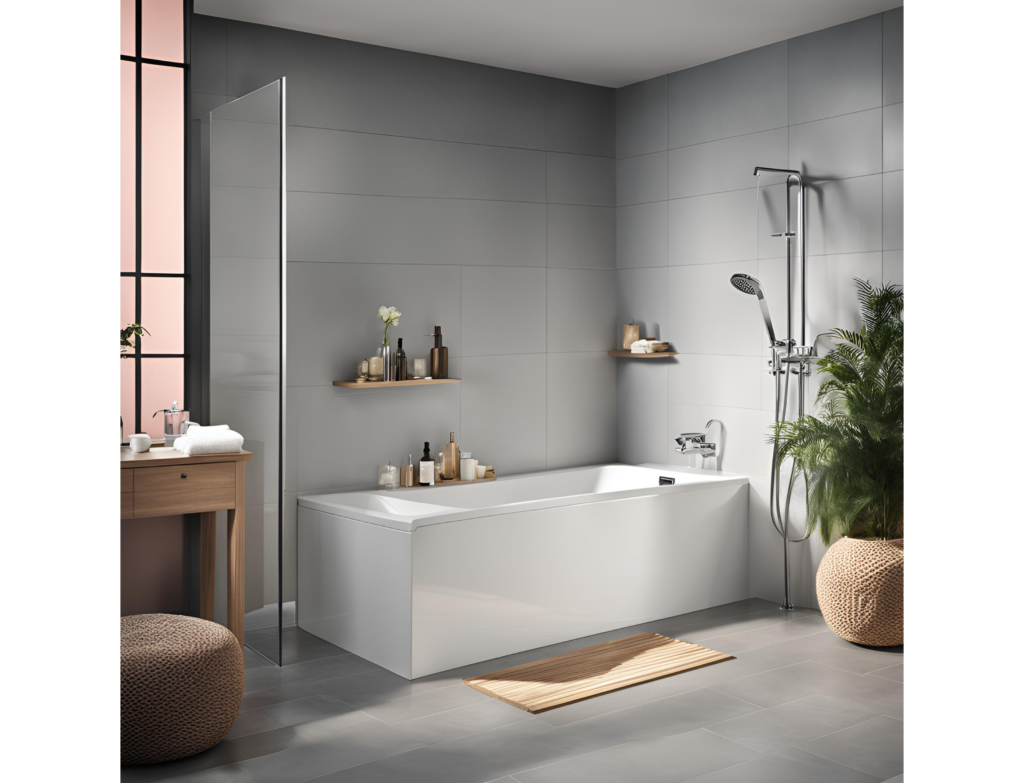
Characteristics:
- Material: Single layer of acrylic.
- Weight: Lightweight and easy to handle.
- Design: Simple designs that fit most bathroom styles.
Advantages:
- Cost-Effective: One of the most affordable bath options.
- Easy Installation: The lightweight nature makes installation a breeze, and the separate panel offers flexibility.
- Variety: Available in a wide range of sizes and shapes.
Disadvantages:
- Durability: Prone to scratches and may not last as long as other materials.
- Strength: Can often be quite flimsy, prone to flexing in some instances.
- Appearance: Acrylic can discolor over time and lose its original shine.
- Creaks: Without reinforcement, these baths can be prone to creaking.
Twin Skin 1 Piece
Twin skin 1 piece baths are a step up in terms of durability and style. “1 piece” means the bath is a single, solid unit with no separate panel. These baths consist of two layers of acrylic (or another material), providing extra strength and insulation. They offer great value for money and come in various shapes and styles.
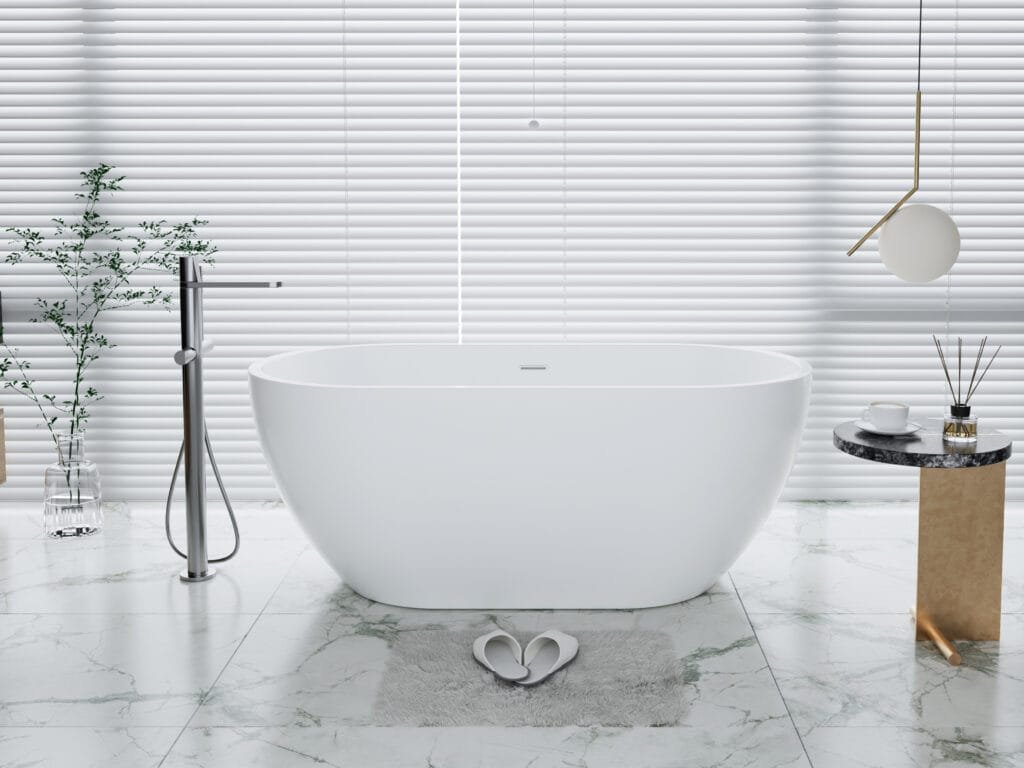
Features:
- Composition: Made from two layers, enhancing sturdiness.
- Installation: Comes in one solid piece.
Benefits:
- Strength: Increased durability due to the dual layers, making it resistant to warping and flexing.
- Insulation: Better heat retention, keeping bathwater at a pleasant temperature for longer.
- Design Variety: Available in more complex and luxurious designs.
- Look: Sleek and minimal, with no need for a separate bath panel. They are an excellent value for money.
Drawbacks:
- Weight: Heavier than single skin baths, but still manageable, ranging from 40-60kg.
- Cost: More expensive due to the extra material and enhanced features, but they hit the sweet spot for reliability, style, and ease of installation.
Solid Surface
Solid surface baths are the pinnacle of luxury and durability. These baths are crafted from a blend of natural minerals and resins, providing exceptional strength and a sophisticated finish. Being a 1-piece bath, they offer a seamless, polished look with no need for an additional panel.
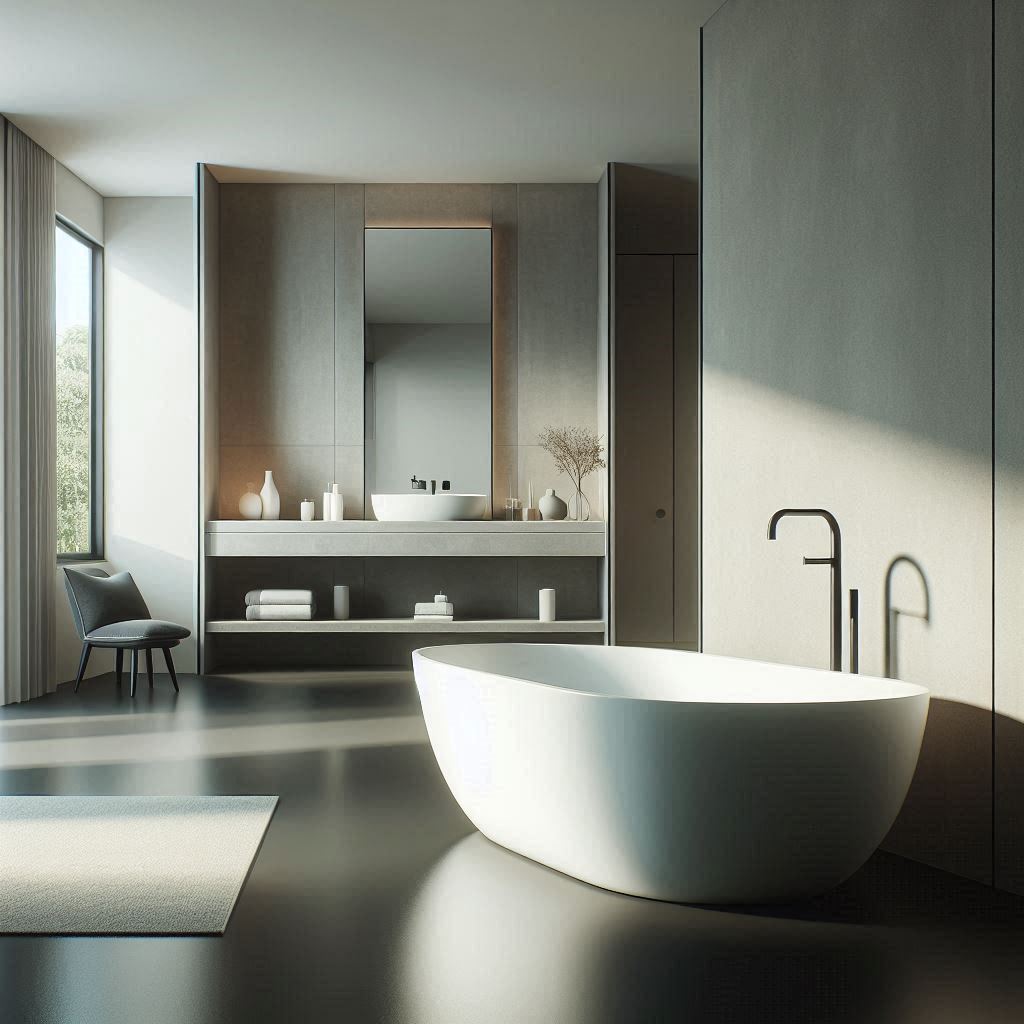
Properties:
- Material: Composite of natural materials and resins.
- Finish: Available in natural or gelcoat finishes.
- Weight: Very sturdy and typically heavy.
Pros:
- Durability: Highly resistant to scratches, chips, and stains, ensuring a long lifespan.
- Repairability: Solid surface baths usually come in two options: natural or gelcoat finish. The gelcoat adds a protective layer but has a drawback—if you damage the gelcoat by, say, dropping something in the bath, any repair attempts will likely be visible because the gelcoat will have been broken. In contrast, non-gelcoat solid surface baths are easier to repair; dents and scratches can be fixed quickly and almost invisibly if done correctly.
- Luxurious Appeal: Seamless, high-end look with a smooth finish.
- Heat Retention: Excellent at keeping bathwater warm due to the dense material.
Cons:
- Weight: Solid surface baths are heavy, ranging from 70-120kg, and require a reinforced floor and professional installation.
- Cost: Typically the most expensive option due to the premium materials and craftsmanship.
- Maintenance: While very durable, maintaining the finish may require occasional polishing. Gelcoat finishes, in particular, may be harder to repair without visible signs, whereas non-gelcoat finishes are easier to restore.
Metal Free-Standing
Metal free-standing baths, like those made from copper or tin, bring a timeless, vintage charm to your bathroom. These baths are typically a single piece with no separate panels, making them a stunning centerpiece in any space.
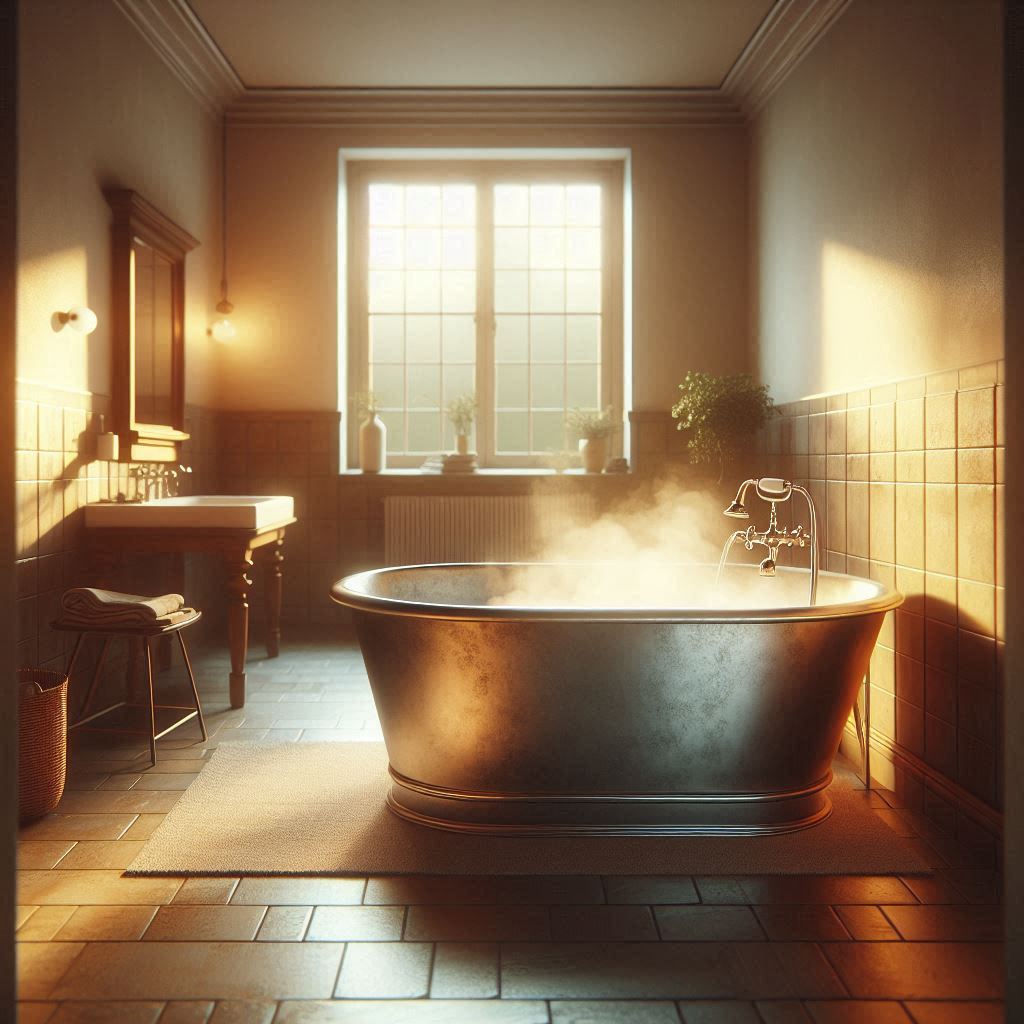
Characteristics:
- Material: Typically made from metals like copper, tin, or stainless steel.
- Weight: Heavy and robust, often requiring a strong floor.
- Design: Usually designed in a classic, freestanding style.
Advantages:
- Aesthetic Appeal: Metal baths offer a unique, vintage look that adds character to any bathroom.
- Durability: Metals like copper and stainless steel are incredibly durable and can last a lifetime.
- Heat Retention: Metal baths, particularly copper, retain heat well, allowing for longer, warmer soaks.
- Antimicrobial Properties: Copper baths naturally resist bacteria and other microorganisms.
Disadvantages:
- Cost: These are high-end baths, and their prices reflect the craftsmanship and materials.
- Maintenance: Metal baths may require more maintenance to keep their finish looking pristine, especially copper, which can develop a patina over time.
Differences in Materials
When choosing a bath, the material is a crucial factor. It influences the look, feel, durability, maintenance, and cost. Let’s explore some popular materials: Acrylic, Solid Surface, and Metal.
Acrylic
Acrylic is widely used for baths, offering a good balance between cost and functionality.
Pros:
- Cost-Effective: Generally affordable, making it a popular choice for budget-friendly renovations.
- Lightweight: Easy to install and handle without needing reinforced flooring.
- Heat Retention: Retains heat well, keeping bathwater warm longer.
Cons:
- Durability Issues: More prone to scratches and scuffs, although these can often be buffed out.
- Flexibility: Single skin acrylic may flex and squeak under certain weights, twin skin baths can be very stable though
- Appearance Over Time: The glossy finish can dull and discolor over time, requiring maintenance.
Solid Surface
Solid surface baths are known for their luxurious appearance and robust build.
Advantages:
- Durability: Extremely tough, resisting scratches, chips, and stains for a long-lasting pristine look.
- Luxurious Finish: Offers a high-end aesthetic with seamless finishes and a soft, natural feel.
- Repairability: Non-gelcoat solid surface baths are easy to repair, with virtually invisible results if done correctly. Gelcoat finishes add protection but are harder to repair invisibly if damaged.
- Heat Retention: Excellent at maintaining water temperature, enhancing the overall bathing experience.
Disadvantages:
- Weight: Quite heavy, requiring reinforced flooring and professional installation.
- Cost: Solid surface baths are on the higher end of the price spectrum due to their premium materials and craftsmanship.
- Maintenance: Regular polishing may be needed to maintain the shine, especially for non-gelcoat finishes.
Metal
Metal baths, particularly those made from copper or tin, offer a distinctive and durable option.
Advantages:
- Durability: Metals like copper and tin are incredibly long-lasting and can endure heavy use.
- Unique Look: Adds a vintage or industrial style to the bathroom.
- Heat Retention: Metals, especially copper, retain heat exceptionally well.
- Antimicrobial Properties: Copper naturally resists the growth of bacteria.
Disadvantages:
Cost: High upfront cost due to the materials and craftsmanship.
Maintenance: May require regular upkeep, especially for copper, to prevent tarnishing.
Cost Considerations
When selecting a bath, cost is a significant factor. It’s essential to consider both the initial expenditure and the long-term value each type of bath offers.As with everything I recommend you always go for best value rather than lowest cost.
Initial Costs
The upfront costs for 2 piece single skin acrylic, twin skin 1 piece, solid surface, and metal baths can vary widely.
- 2 Piece Single Skin Acrylic: The most budget-friendly option, typically ranging from £200 to £700.
- Twin Skin 1 Piece: Usually between £800 and £1800
- Solid Surface: From around £1,500 to £3000 or more, depending on quality, style and brand
- Metal Free-Standing Baths: These can be quite expensive, reflecting their craftsmanship and unique materials, often costing upwards of £3000
Long-Term Value
Beyond the initial cost, consider the long-term value, including durability, maintenance, and energy efficiency.
- 2 Piece Single Skin Acrylic: Lower initial cost but may require more frequent replacement or repairs.
- Twin Skin 1 Piece: Offers a good balance of durability and cost, providing long-term value.
- Solid Surface: High initial cost but offers exceptional longevity and minimal maintenance, making it a good long-term investment.
- Metal Free-Standing Baths: Expensive but highly durable, often lasting for generations, which can justify the higher upfront cost.
Conclusion
Choosing the right bath involves balancing style, functionality, and budget. Whether you prefer the affordability of a 2 piece single skin acrylic bath, the sturdiness of a twin skin 1 piece, the luxury of solid surface, or the timeless elegance of a metal free-standing bath, understanding the unique features and benefits of each type will help you make an informed decision. Consider the long-term implications of your choice, including installation, maintenance, and how the bath will integrate with your overall bathroom design. Whatever you decide, your bath should be a place of relaxation and rejuvenation, perfectly suited to your lifestyle and taste.
This comprehensive guide should help anyone in making an informed decision on the best type of bath for their needs! If you are interested in The Border Bath Company Range of baths, head over to their partner retailer Warwick Bathroom Company
Check out our other guides on all things bathrooms by heading over to our blog